To paraphrase the credo of zero waste chef Anne Marie Bonneau, humanity doesn’t need a few people perfectly achieving zero waste in their kitchens (or anywhere else for that matter), we need millions of people imperfectly reducing their waste wherever they can.
When it comes to kitchen waste, it might be surprising to realize how much disposable waste (i.e. landfill) even an aspirationally conscientious kitchen can produce, something I have wrestled with throughout my own ongoing waste reduction journey.
If you’ve ever been curious about how you can start, or continue, reducing waste in the kitchen, I offer below my evolving and non-exhaustive list of reusable, recycled, recyclable, and compostable solutions that have worked for me, from DIY and low cost solutions using what you already have, to various products replacing disposables that make their initial investment more than worthwhile.
Disclaimer: Any products pictured come from my own household and were not paid for or provided for this article.
Jump to:
- Thoughts on encouraging change
- Thoughts on affordability
- Reusing your own kitchen supplies and disposables
- Compostable or recyclable kitchen disposables
- Reusable “paper towel”
- Glass jars, even for the freezer
- Stainless steel containers
- Silicone stretch lids
- Silicone storage bags
- Silicone baking sheets
- Beeswax food wraps
- Reusable fabric pouches
- Reusable produce and bulk bags
- Reusable cheesecloth
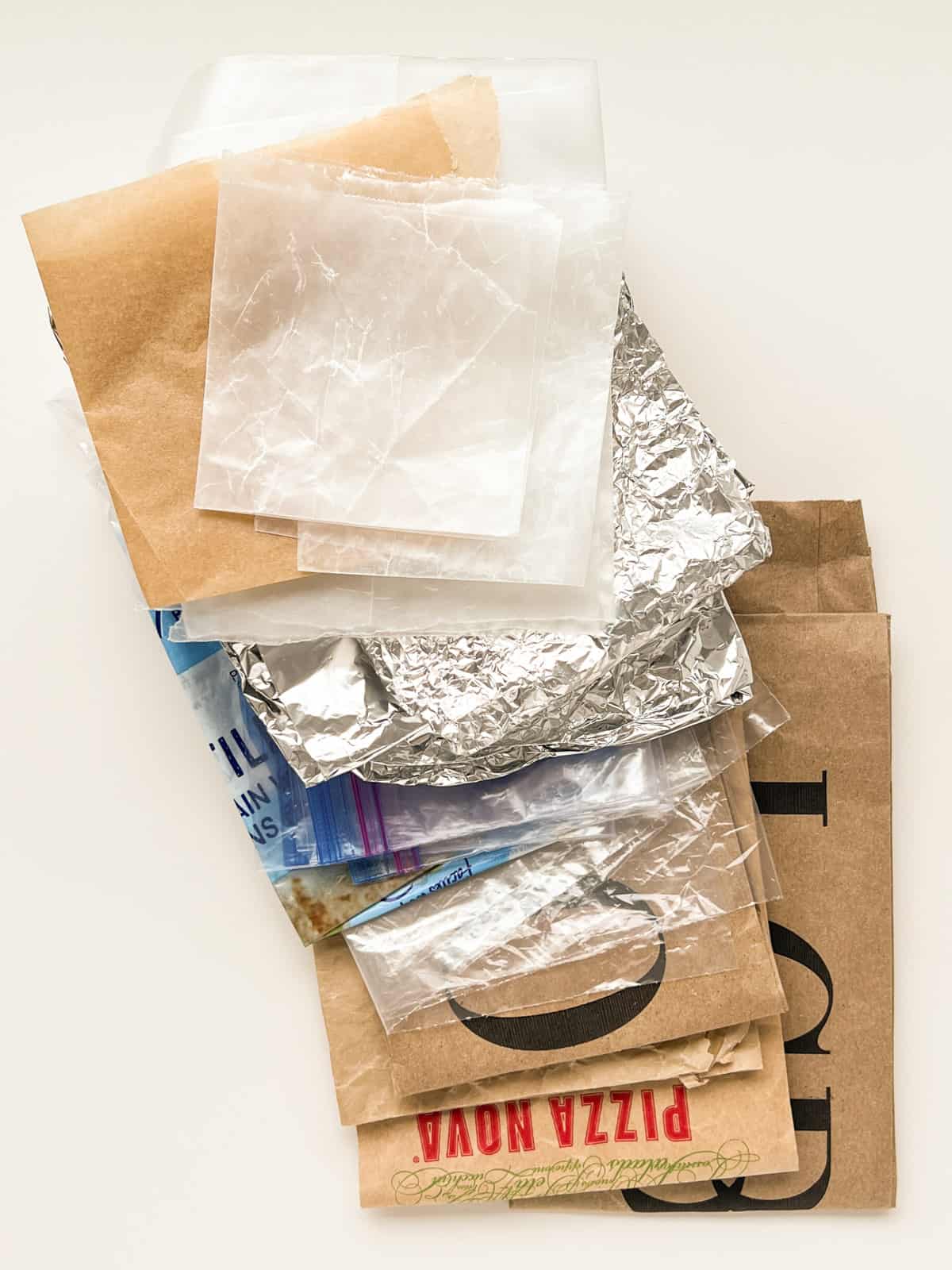
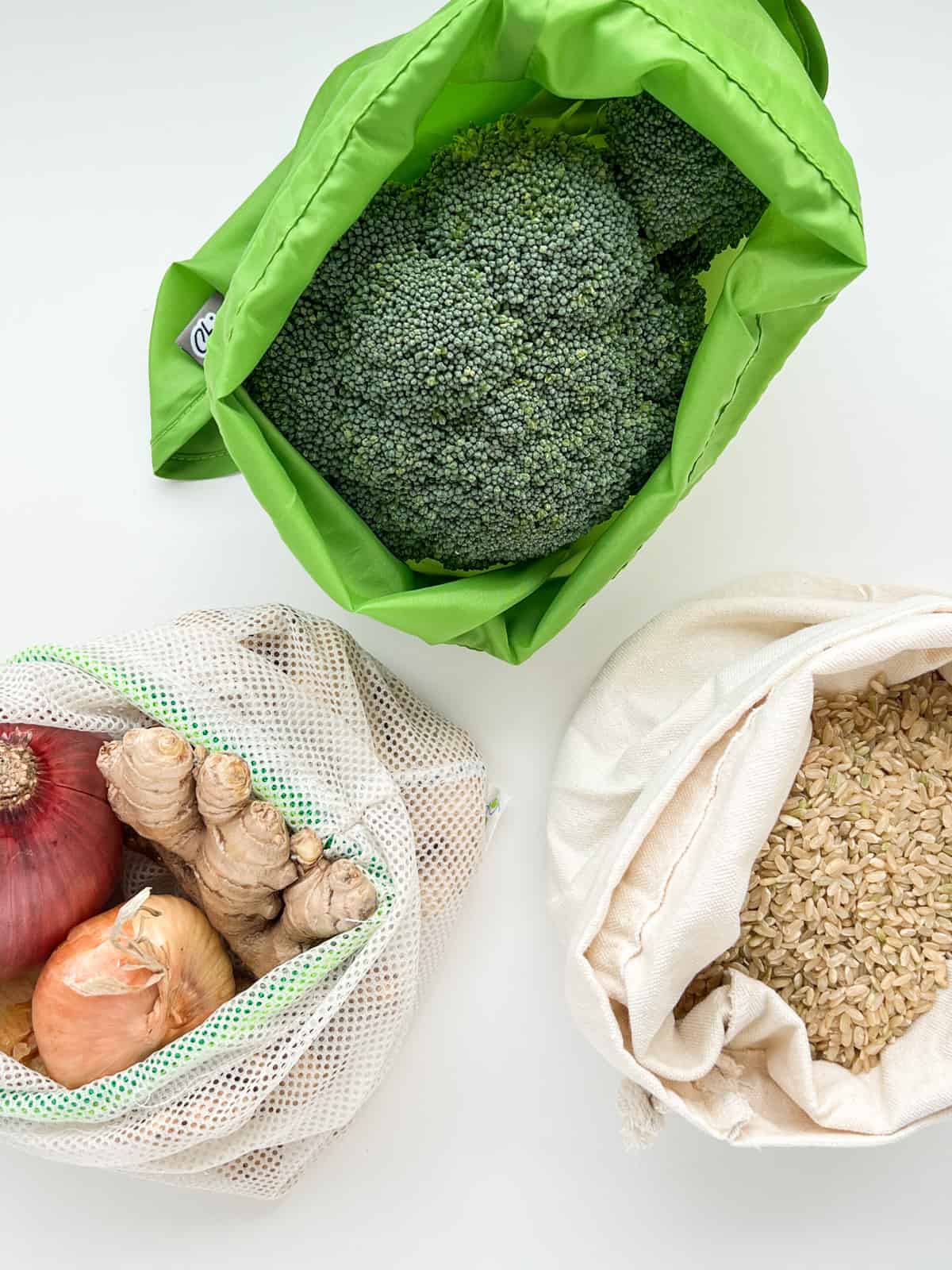
Thoughts on encouraging change
Making ecologically conscientious decisions can seem difficult. It’s so easy to fall into the thinking trap of doing nothing if we can’t do it all, if we can’t do it all at once, or if we can’t do it perfectly. I can say from personal experience, it is easy to feel overwhelmed and do nothing. However, the concept of imperfect but necessary action has given me solace and confidence to try to change my own habits over time, alongside the knowledge that I have the privilege and resources to think about enacting change, which many do not.
I am constantly imperfect in my actions. I still buy a package of ziplock bags every now and then and I use plastic bags when I forget my reusables, amongst many other stumbling blocks along the road of my best intentions. However, I can see my actions are making a difference in my own household in how I consume disposables and how much landfill bound waste I produce, and that gives me the encouragement to keep trying.
Reducing waste in the kitchen requires mindful action - it doesn’t happen by itself, and it certainly doesn’t happen overnight. My process has been to focus on one or two solutions at a time, and to build capacity within my kitchen to have these new habits become the status quo. I pick an item I want to swap out for a more conscientious alternative - plastic ziplock bags let’s say - and focus on the solution for that item. When I have solved that issue for the most part, I move on to the next. Sometimes an opportunity presents itself, like finding a big bag of silicone pouches at a thrift store or finding a great DIY tutorial, that pushes me to make a change I had been considering but hadn’t yet acted on.
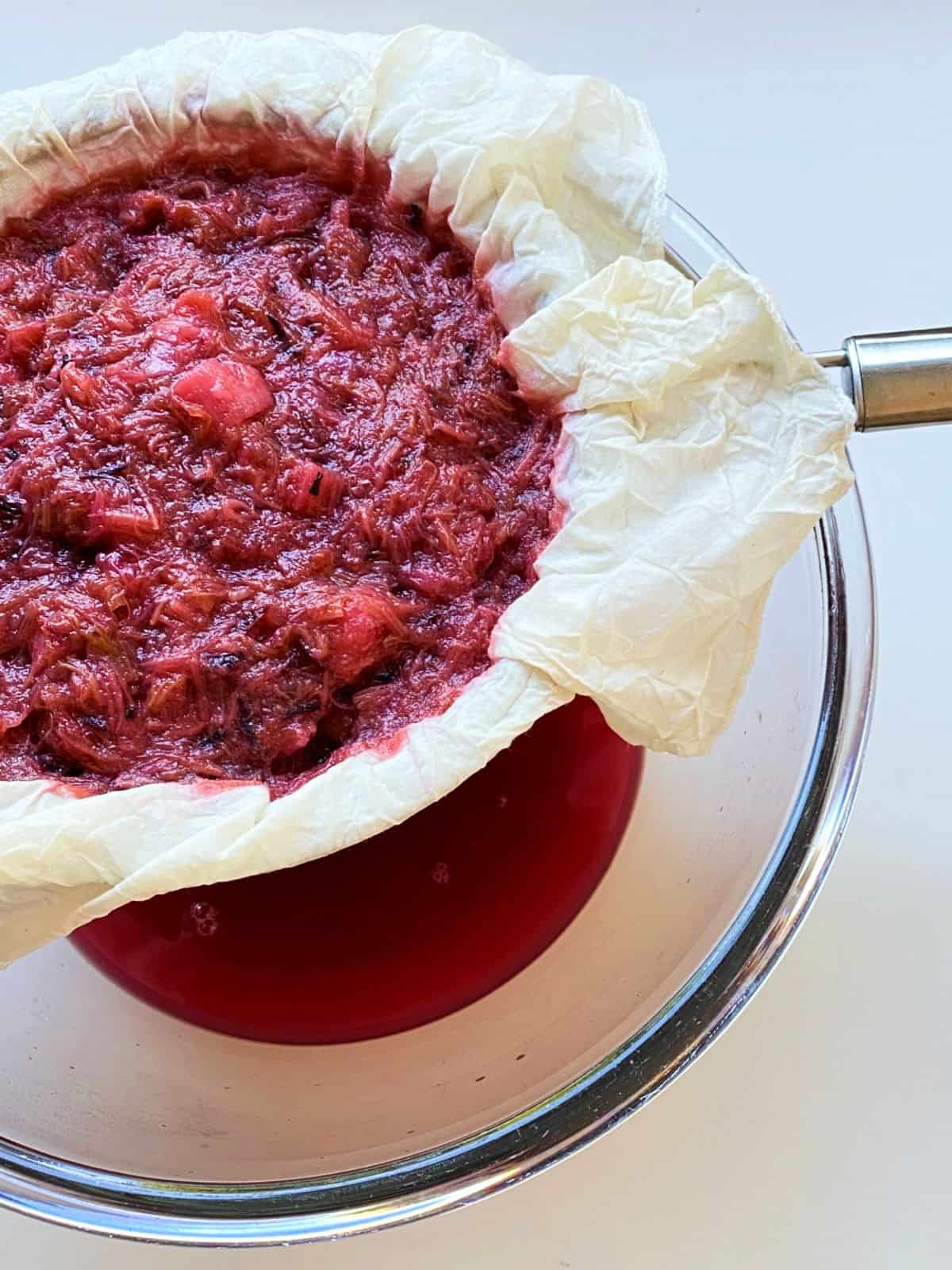
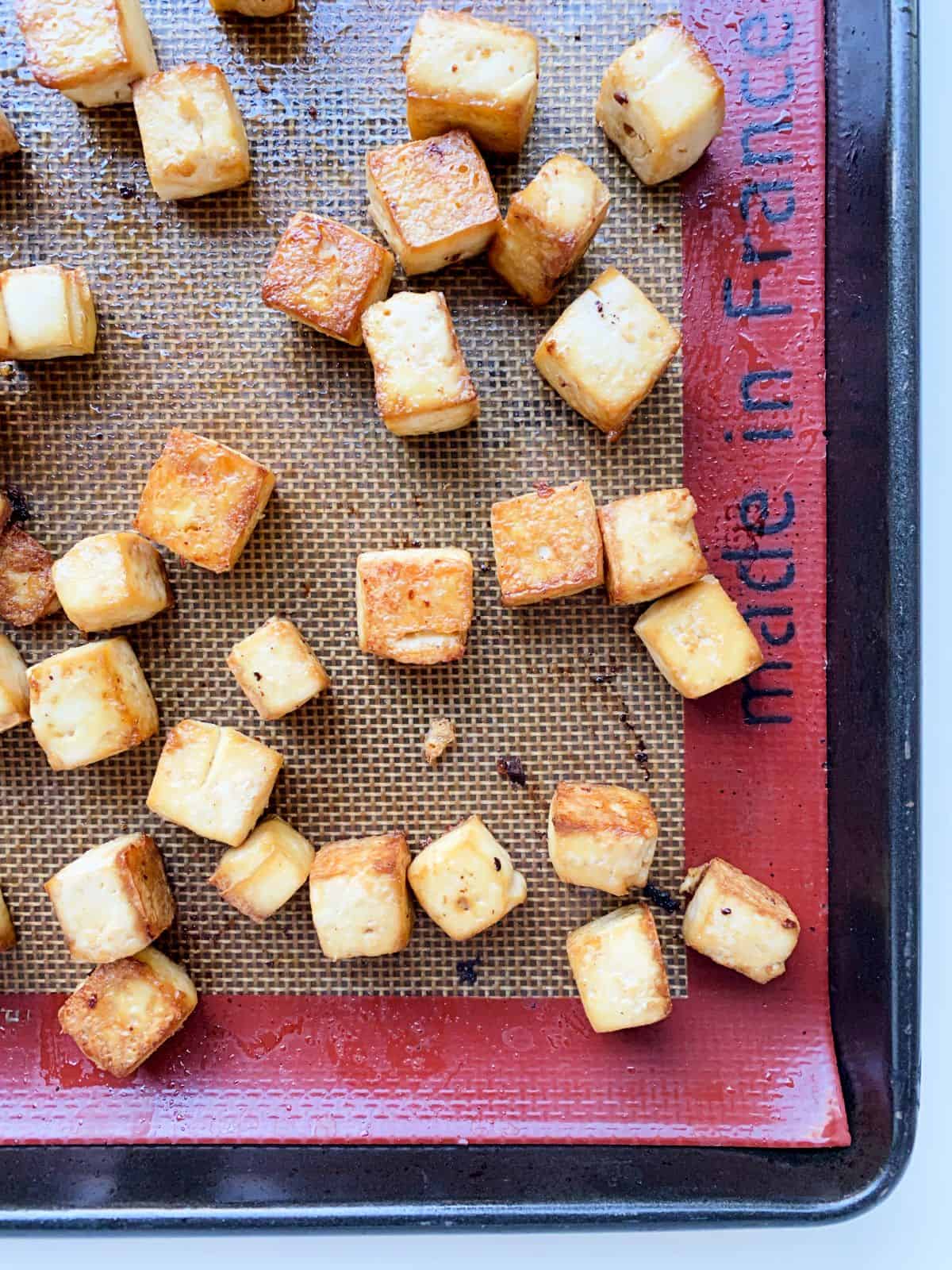
Thoughts on affordability
While you might have the rightfully earned impression that switching to reusable, recycled, recyclable, or compostable kitchen products or practices would be too pricey for your household, the great news is that new products are making their way to the mainstream market all the time, at increasingly affordable prices, and there is an explosion of low cost DIY how to’s available web wide.
On the topic of cost, here’s a useful case in point: while spending $20 on a set of silicone stretch lids may seem, in isolation, an unjustifiable expense, consider the cost of the products those lids have replaced; I have rarely purchased plastic cling wrap for the past ten years thanks to that one time investment, so the amount of money I have saved is surely many times more than the initial cost.
This adjustment in thinking, from cheaper products more often, to potentially more expensive products way less often, was a shift in how I thought about product consumption that took some getting used to. Just changing habits, from what we grew up doing, to solutions we can seek out now, is also a shift in thinking that requires some attention.
Some of these solutions cost nothing, and some require a small investment of time or a modest financial investment. Pick one approach that makes sense to you in your daily routines and household budget, start with that, and then move on when you can. It might come as a surprise how much change you can make over even a short period of time with one or two doable actions! You’re probably already doing some or many of these things, and perhaps a reflection of that will offer needed encouragement to keep going in other areas.
Reusing your own kitchen supplies and disposables

Let’s start off with how waste can be reused from what you already have in your own kitchen waste stream. This may seem obvious, but then again maybe it isn't’! I think many of us have been conditioned to think that single use products are cleaner than something re-used, and also not appropriate for reuse, so it can take a bit of an adjustment to alter that perspective.
Of course I try to reduce the amount of packaging that I bring into my household, but the reality is, a lot still finds its way into my kitchen. With that in mind, I have made a point of keeping and reusing any and all clean bags and wrappings that I can - everything from paper bags from the bulk barn or wine store, to clean plastic or ziplock style bags that contained bread, tortillas, or vegetables for example - are fair game for reuse and can be used to wrap up a lunch, snack, or something going into the fridge or freezer.
If I use foil or parchment paper to wrap something that isn’t greasy or messy, a quick shake or wipe means I can fold up the used item, store it in a drawer and reuse that wrapping once again, or maybe even a number more times. I find I go through less wrapping products this way, and if I’m buying things packed in single use plastic, at least I can reuse those items more than once before putting them into the recycling or garbage as required.
Once you start saving what used to be single use waste items, you’ll find there’s lots more to reuse from what you are already bringing into your household, from plastic fruit and vegetable containers, to cookie and chocolate tins, plastic take out packaging, glass bottles, and more; even the elastic bands and twist ties on bunches of greens are fair game to save and reuse.
Compostable or recyclable kitchen disposables
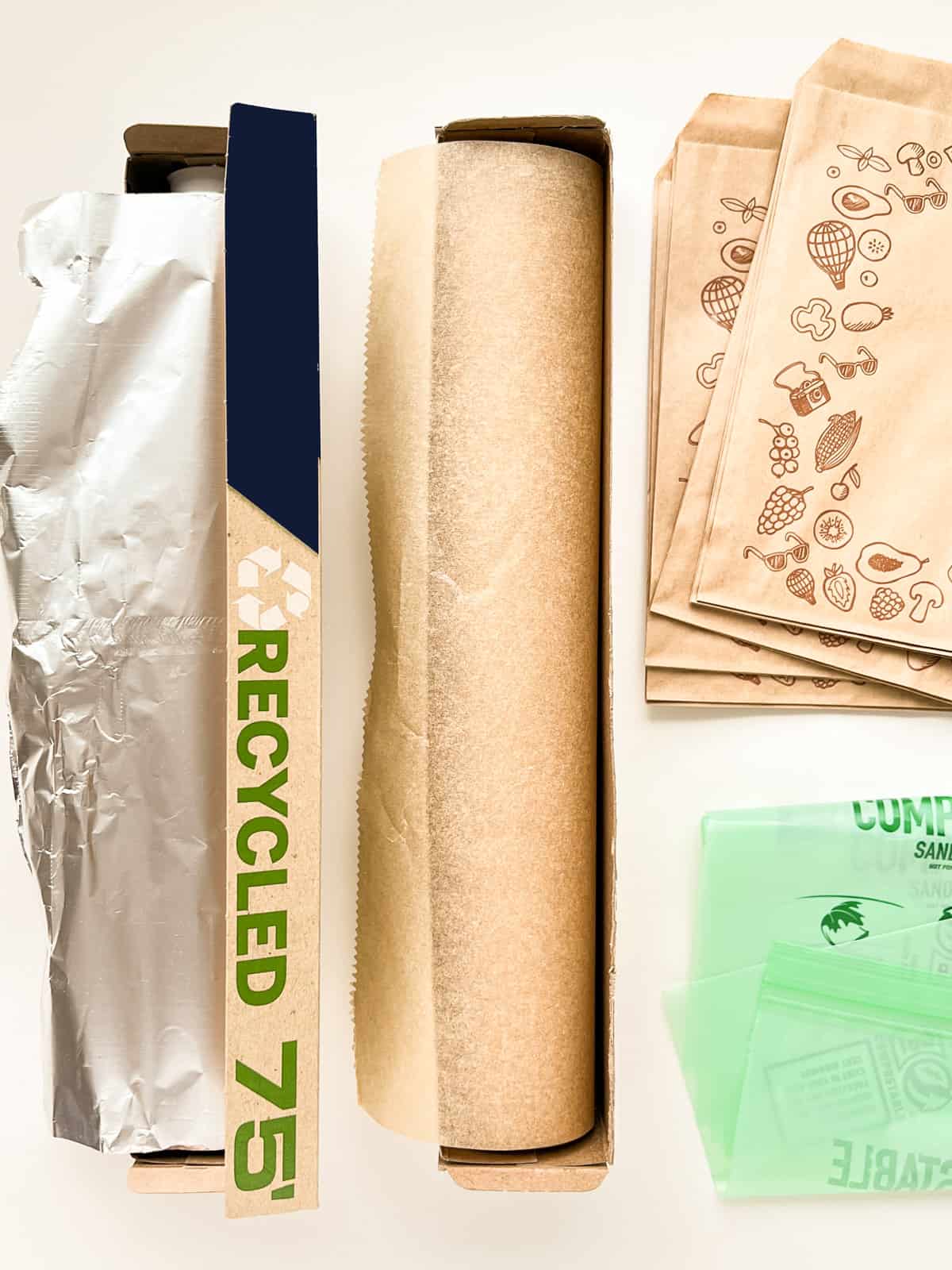
While my goal is to predominantly use only reusable products, the truth is that there are some disposables that I find indispensable or hard to fully replace, so I have tried to substitute them with more ecologically conscious versions, and luckily, that is getting easier with time. While eco-conscious disposables used to be the sole provenance of pricey health food stores, new, more affordable products debut regularly that are increasingly available at mainstream sources, including various ubiquitous big box stores where the pricing can be quite competitive.
In my kitchen I use recycled aluminum foil whenever possible, compostable parchment paper if I am not using silicone baking sheets, recycled paper snack/sandwich bags, and biodegradable ziplock style bags for those times when I would be tempted to use single use plastic.
Reusable “paper towel”
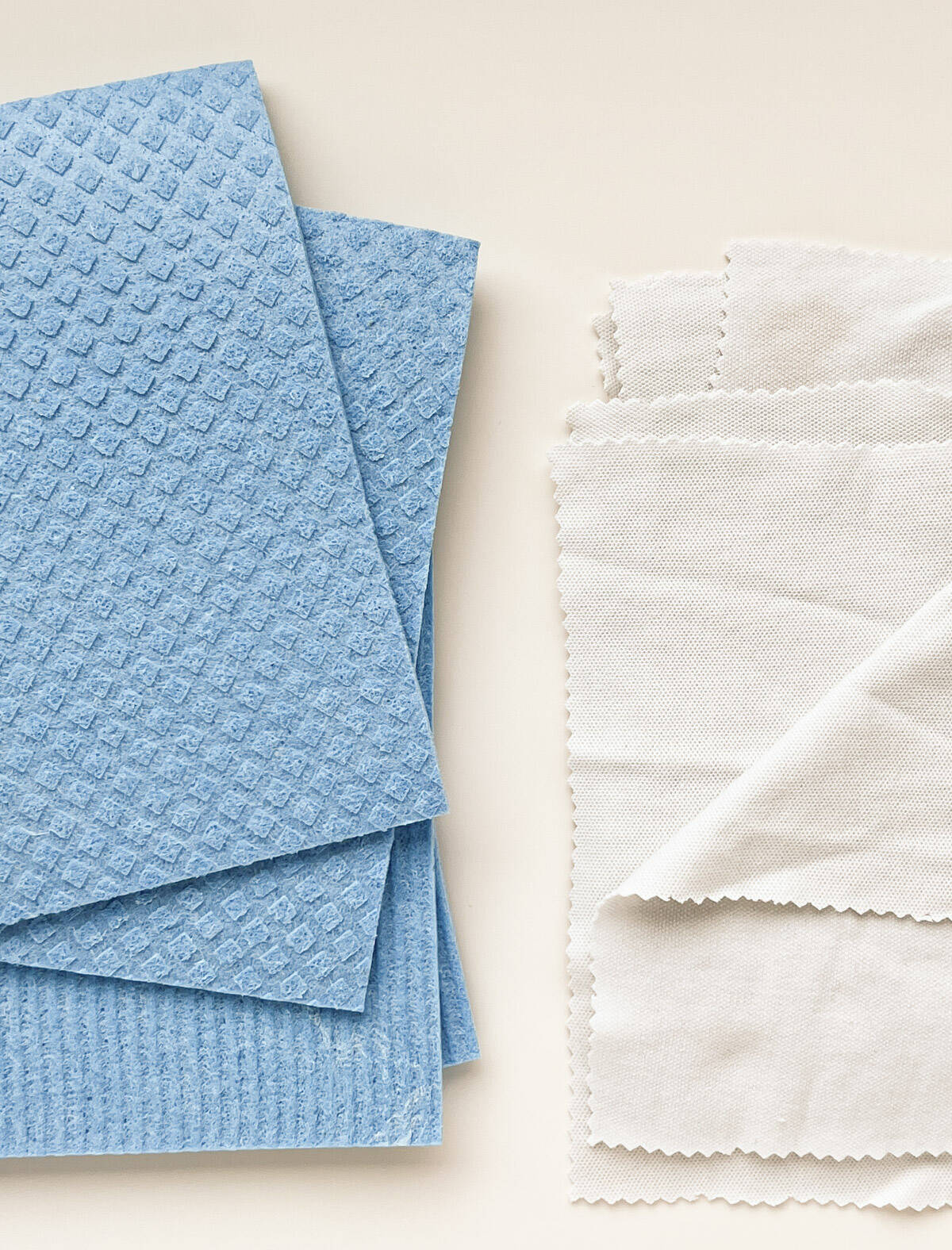
Another item that is really hard to get rid of from the kitchen is paper towels. While I do buy a pack once or twice a year at most, I have almost completely switched to “reusable” paper towels made from cellulose, although other cloth based styles are available. These large, thin sponges can be used as paper towels, and for general household cleaning, and can be laundered along with your household laundry over and over again for reuse.
Over time, cellulose based products do show signs of wear and tear, and once they get to the end of their life cycle, they can be recycled or composted depending on what they are made of. I have found an affordable brand that is 100% cellulose and compostable, so check the label if you decide to give these a try; I personally find these reusable towels indispensable and well worth the cost when compared to the regular use of paper towels.
Want a DIY solution ? A great no cost alternative to buying specialized paper towel replacements is simply to make your own. You can pretty quickly create stacks of clean, absorbent paper towel sized cloths that are cut from textile waste from your own home; use absorbent natural materials, and cut out your towels using pinking shears if possible, as this will help avoid the material shredding when being laundered.
Make it at home! Use this visual tutorial to sew up a set of double sided “un-paper” towels.
Glass jars, even for the freezer

While numerous aesthetically pleasing and expensive storage systems for pantry goods and fridge and freezer storage are widely available and certainly tempting, one of the most useful and affordable kitchen storage solutions I have found is using inexpensive and ubiquitous mason jars (the kind used for making jams and preserves), alongside reused glass jars recycled from my own kitchen waste stream.
A dozen mason jars can be bought new for less than the cost of one brand name storage container, they are easily thrifted for even less, and various products from pasta sauce to condiments come packaged in jars that are eminently reusable. I use glass jars for storing almost all of my dry pantry goods, in sizes ranging from a capacity of half a cup, to a full litre, moving up to more capacious jars with snap lids that I find at kitchen supply stores or thrift stores, for larger quantity items like flour, oats, and sugar.
Glass jars essentially last forever until broken, don’t discolour or absorb odors, and standard sized mason jars in particular can be customized with various kinds of lids that are available in stores and online, from standard canning lids, to reusable drinking or pouring spouts, to special lids for fridge or freezer storage, making them useful in many different ways.
You may not know that glass jars are also useful for freezing as long as you don’t overfill the jar, make sure to leave headspace for expansion, and use straight sided jars when possible to further reduce the possibility of cracking. Freezing in glass jars is not as risky as it may seem, and after years of using jars to freeze everything from broth to soup, I have had very few incidents of cracking or breaking.
Stainless steel containers
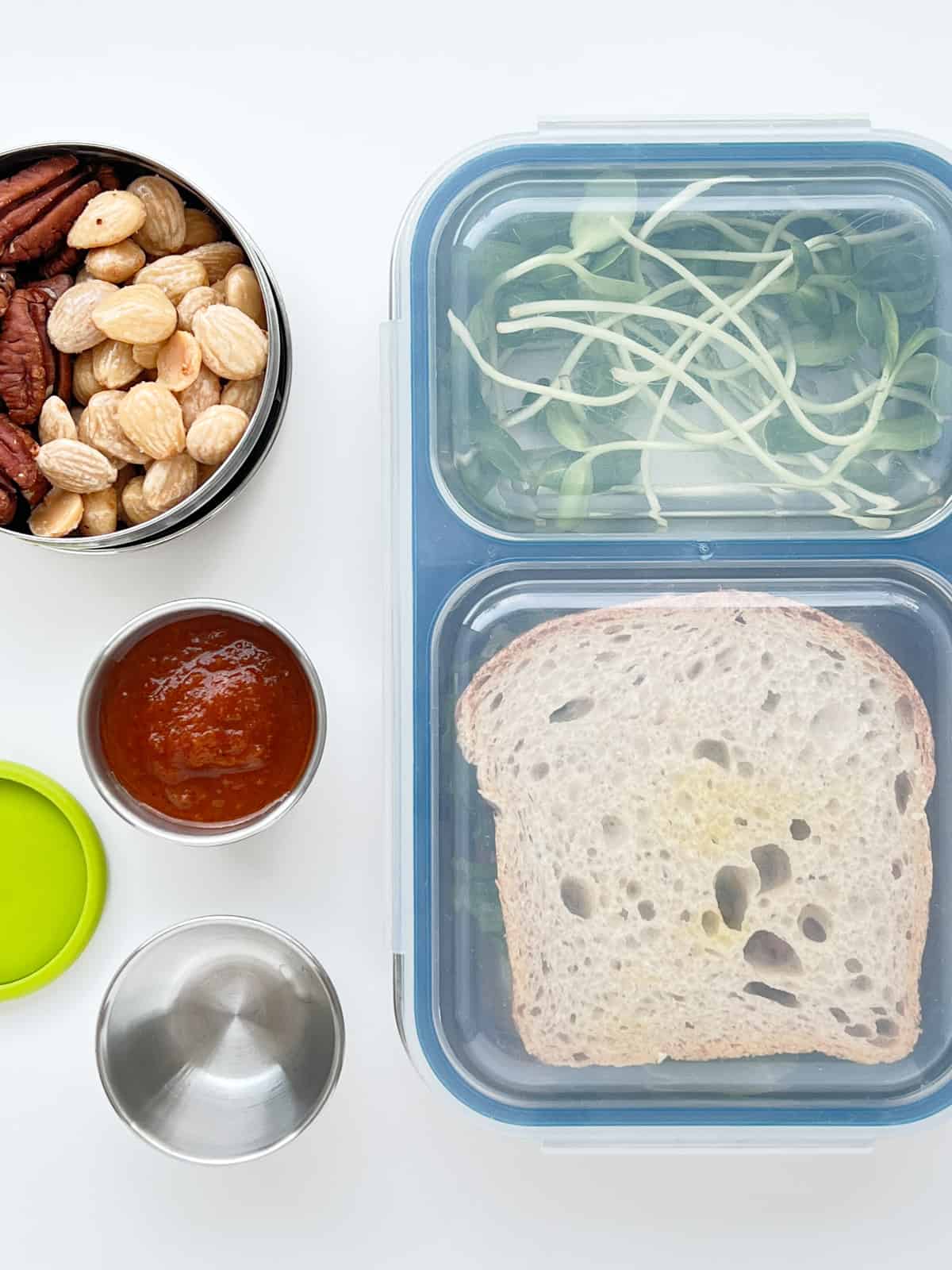
Containers made out of non-reactive stainless steel are useful for packing and storing food as an alternative to plastic tupperware, and make for a lighter alternative to using glass. In general I have found there are two basic kinds of stainless steel containers - those that seal, making them most appropriate for storing food that may contain moisture, and those that don’t seal, best for packing or storing dry goods.
In my kitchen I have a few compartment style containers that I use for lunch or picnics, and a few smaller non sealing containers that I use on the go for snacks, when packing up dry ingredients for camping, or simply to stash something in the fridge. These metal containers can take a lot of wear and tear, are easily washed without special handling, and like glass, don’t take on any food odors or stains making them endlessly reusable. One thing to look out for with stainless steel containers is that there is a wide price range, from overly pricey trendy brands, to more affordable generic versions or tiffin lunch containers, so shop around if you can before deciding on your products of choice.
Silicone stretch lids
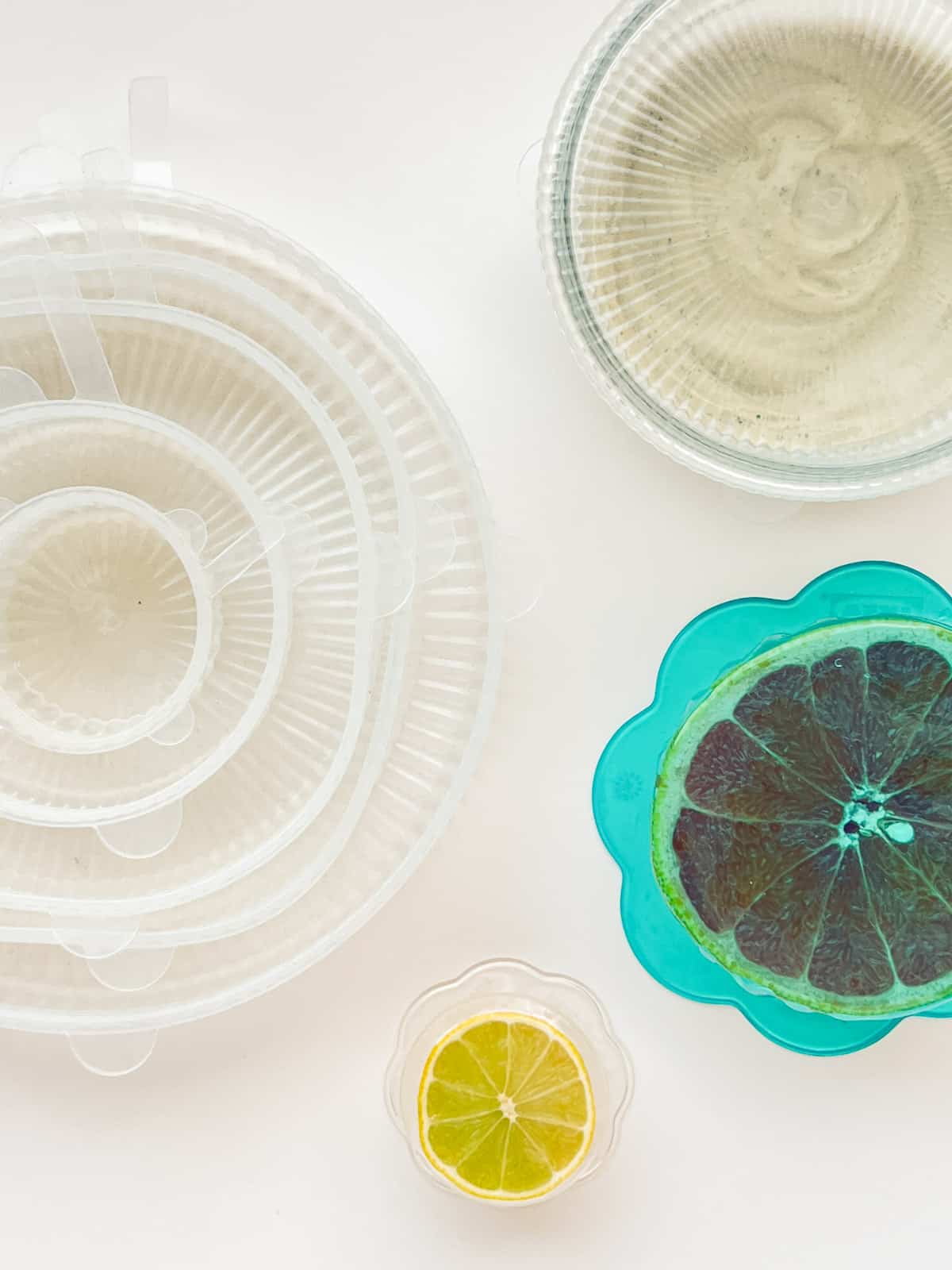
This has to be the single most value for money item I have invested in throughout my waste reduction journey. Over a decade ago I purchased a set of clear silicone stretch lids for about $20 and they are still going strong with almost no wear or tear - how’s that for value!
Instead of using disposable cling wrap, I use the lids to cover containers of leftovers in the fridge, cover bowls of rising dough or cookie mix when baking, or use them simply to wrap cut produce - everything from a cut apple to half a melon can be accommodated with the various sizes of stretchy lids. They can be easily washed in the sink or dishwasher and have held up to regular use with no special handling. I have seen these lids for sale everywhere from local supermarkets and kitchen supply stores to the kitchen section of a certain Swedish furniture store at an unbeatable price.
DIY it! While not waterproof, you can make your own fabric bowl covers to help replace plastic wrap.
Silicone storage bags
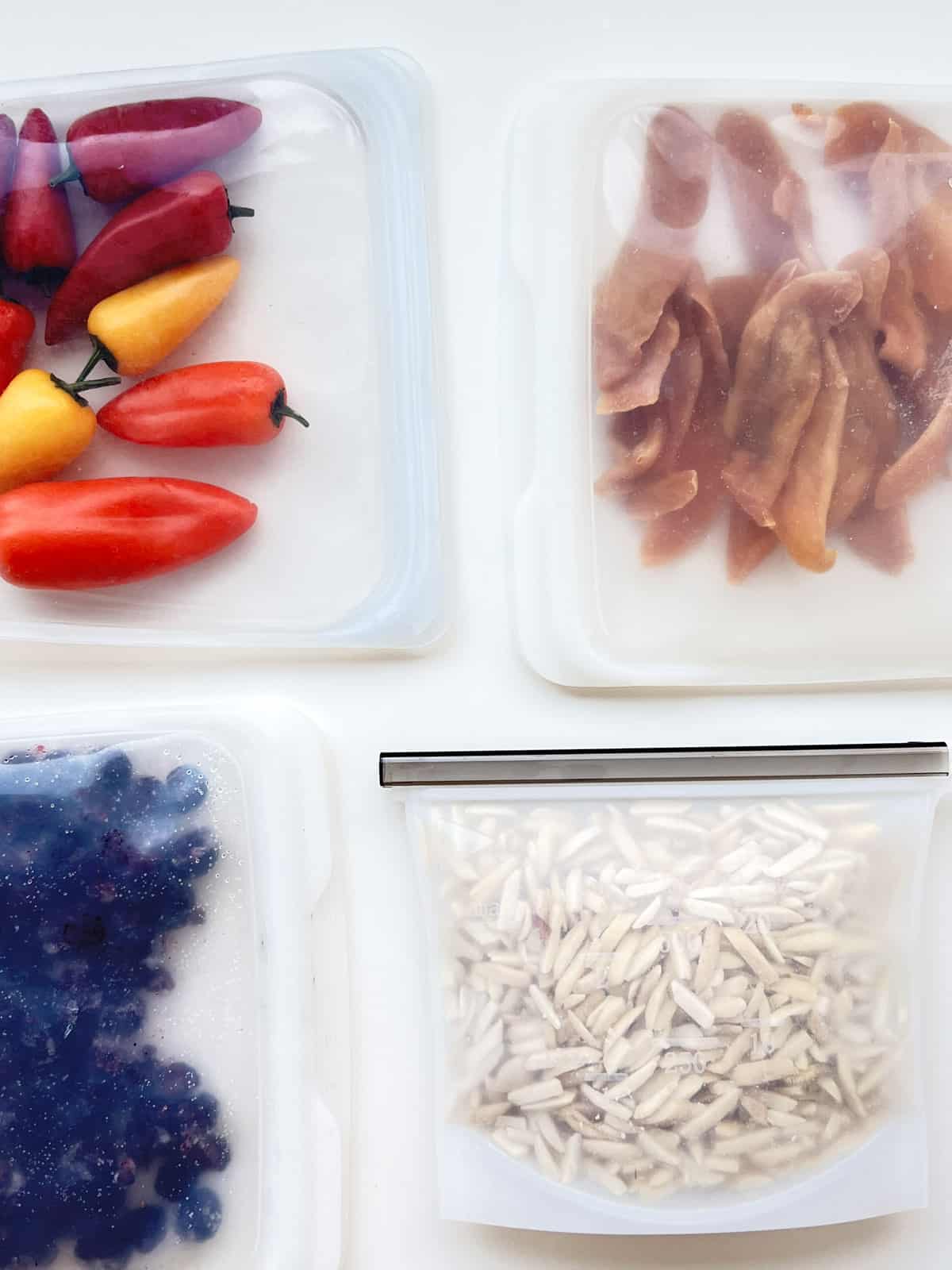
Ziplock bags were, and continue to be, my waste reduction nemesis. They are so useful, so cheap, and so ubiquitous that I found them to be one of the hardest items to stop buying. After not purchasing ziplock bags for quite some time, perhaps even years, I broke down during the Covid epidemic and found myself with a giant pack of a hundred bags in my grocery order. Horrified at the sheer volume of single use plastic bags in just this one box, let alone the many I have used in my lifetime, I vowed to redouble my efforts to remove ziplocks from my kitchen.
Over the last few years I have also been slowly buying silicone storage bags when I find them on sale, and now have a big enough collection to service my kitchen’s needs. By purchasing them gradually, the cost didn’t seem quite as overwhelming, and I know that if I compared what I have spent in my life on disposables to the cost of these reusable items, the case would be clear.
These silicone bags and pouches are an investment for sure, but they last for ages and can be used endlessly - some bags I have in my collection are years old with no wear or tear. If you stay away from some of the trendy big name silicone bags which can be quite expensive, and look for grocery store, big box store, health food store, or online vendor generic brands, you can get some great deals.
I use these bags mainly for storing items in the freezer - everything from bread to summer produce can be accommodated depending on the size of the bag, and they are also useful for storing pantry items or packing picnic, snack, or lunch items. They can be hand washed or tossed in the dishwasher and left to dry upside down on the counter.
There are a few different varieties of silicone bags that I have tried - the pouch style, which replicates a ziplock bag configuration, useful for flatter or smaller items, with a kind of oversized ziplock style closure. The same kind of bag can come in a gusseted version that can stand upright, which is better for bulkier or more voluminous liquid items such as produce, soups, or stews. My personal favourite style is a gusseted pouch that comes with a closing rod - these are a bit more finicky to use, but can be found cheaply online, are quite capacious, and the seal is very secure.
Silicone baking sheets

I used to be one of those people that lined their baking pans with parchment paper every time, so silicone baking sheets have allowed me to reduce my consumption of parchment paper by a huge degree. Useful for everything from baking cookies to baked tofu cubes or roasted vegetables, silicone baking sheets may require an initial investment but can be used for many years afterwards making them good value for money. Silicone can take on odours or discoloration over time, so I have found having two separate sheets, one for savoury items, and one for neutral or sweet items, has made sense in my kitchen.
Beeswax food wraps
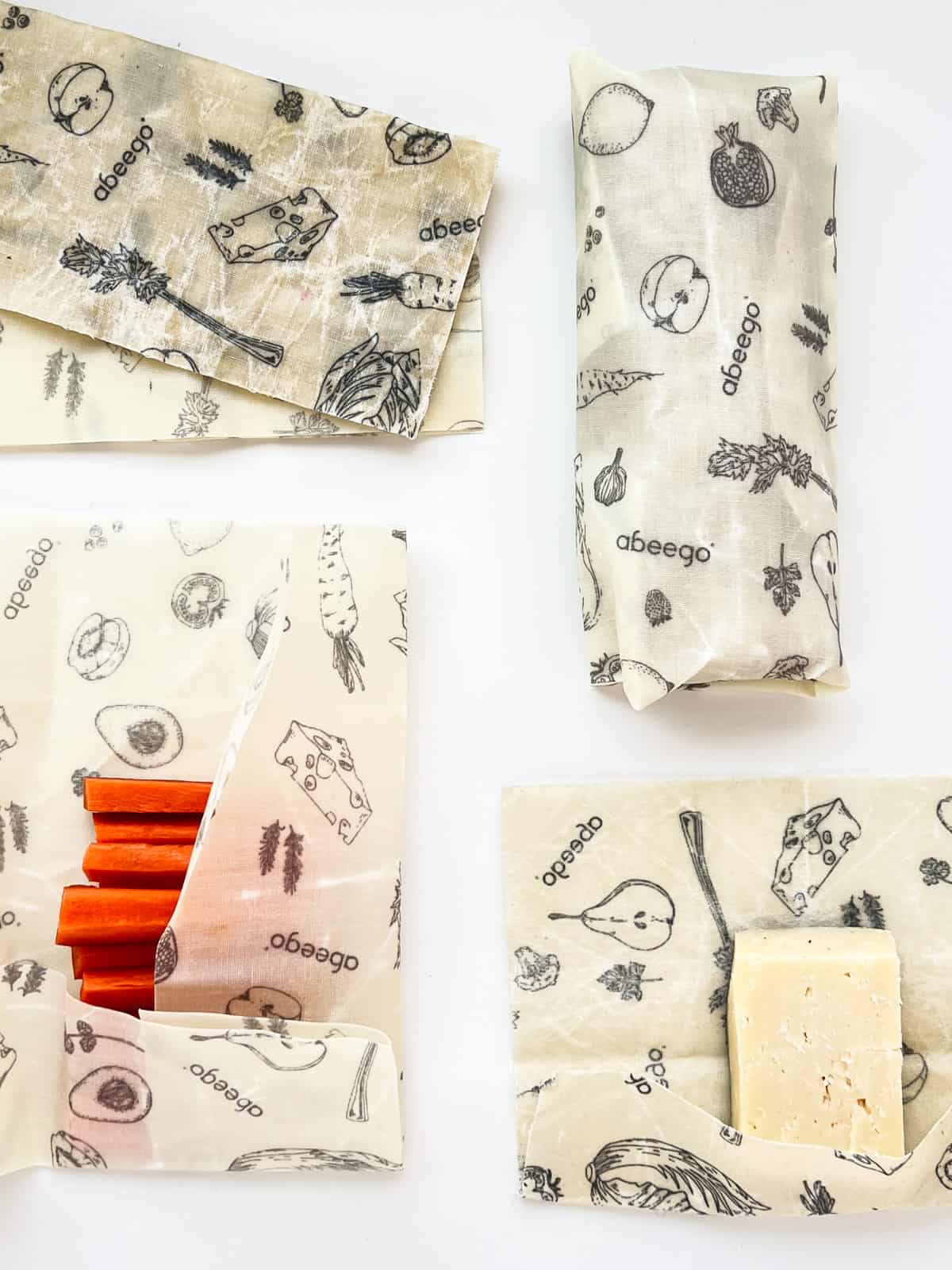
When beeswax impregnated wraps became quite popular in these neck of the woods, I chanced upon a sale and invested in a set of various sizes that proved to be a great starter product during my waste reduction journey. I used these wrappings vigorously until they came to the end of their life, and I still find them useful with some reservations.
These wraps are well suited as a replacement for cling wrap, from wrapping cut apples or carrots, to enclosing a sandwich. Their waxed surface is not sticky to the touch but sticks to itself, meaning you can get a nice tight wrap, fashion a little pouch out of larger wrap, or use the wrap to cover a bowl as you would plastic wrap.
I find this style of reusable wrap doesn’t keep moisture in all that well, so it is not suitable for wrapping anything juicy or especially wet. While they are touted as being great for wrapping up fridge items like cheese, I found that some cheeses dried out while wrapped up quicker than expected.
With regular use, and careful washing in cold water, these wraps can be reused over and over again for a year or more, at which point you may notice the beeswax coating starting to degrade. At the end of their lifetime I cut these wraps into thin strips and use them while camping to help start campfires as a kind of DIY firestarter.
Make it yourself! Use this comprehensive article as a guide to make these wraps at home, including a vegan version for those that don’t use bee products.
Reusable fabric pouches

Various sizes of fabric snack bags are available at many different kinds of stores, making them easy to find. I have found just having a couple available in my kitchen makes for a useful addition to my lower waste arsenal; these small or medium sized pouches are very useful for packing snacks, from crackers to nuts, or cut fruit and veg, to slices of homemade banana bread, and they can be rinsed in the sink or thrown in the wash when needed. I often find myself tucking a snack into one of these pouches, and they double duty as little storage bags for “stuff” that you have floating around in your knapsack or bag that needs a temporary home.
Feeling crafty? Make your own handmade snack bags with this handy visual tutorial.
Reusable produce and bulk bags

One stream of disposable waste in any kitchen occurs when shopping - everything from plastics used to bag up fruit and vegetables, to containers at the bulk store, can contribute to waste that comes into the kitchen that then has to then be disposed of. While we are all now conversant with the use of reusable shopping bags, which easily replace plastic grocery bags, there are a few great solutions available that can also help reduce additional waste.
When I pack (or rather messily stuff) my reusable grocery bags into the back of the car, I make sure to throw in a handful of reusable netting produce bags. Available in various sizes, I have used these bags too many times to count when shopping for fruits and veggies instead of the plastic bags available on rolls in the produce section. Recently I have added some simple cotton bags into the mix, which can be used to hold similar items, but can also do double duty at the bulk store for items like bulk pasta, beans, rice, or other dry goods, and can also store dry produce like potatoes, onions, or ginger in the pantry. I’ve also used a third variety of bag, a reusable “green” bag which helps to hold moisture in, making it a bag I can use at the store and then in the fridge for herbs, greens, beans, broccoli, and other items that would wither if left uncovered in the fridge.
Know how to sew? Check out this step by step guide to making your own drawstring bulk food bags at home.
Reusable cheesecloth

Cheesecloth is something I use regularly in my kitchen, for everything from straining broth, and making ricotta, to making cordials. In general, standard cheesecloth cannot be reused and ends up being a waste product, even if not a very frequent one. As part of my lower waste journey I was thrilled to find reusable cheesecloth - precut and edge finished circles of super fine organic unbleached cotton - that can be used over and over again. This handy product, available in various sizes and shapes, is finer than standard cheesecloth meaning it’s more effective at straining, and can be easily washed in the sink or the laundry and used until … well, forever.
DIY option: If you’re able to source unbleached fine weave cheesecloth, sackcloth, “butter” muslin, or lint free flour sack tea towel, you can easily make up some of your own reusable straining cloths - just make sure you sew or serge the edges so that loose threads don’t end up in your cooking!
There are certainly many more solutions to reduce disposable waste in the kitchen, and I look forward to continuing to shift my habits and to sharing a second installment of ideas in the future.


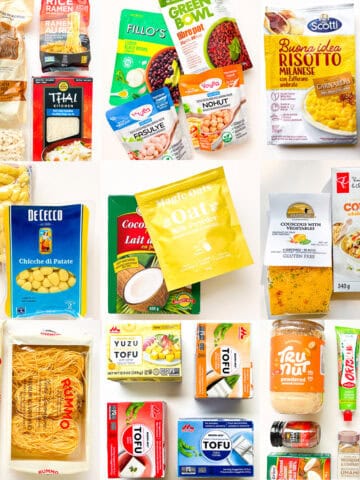
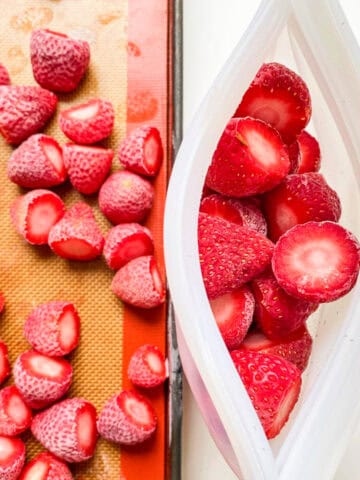

Saba F says
Great article, thanks for sharing these great tips and tricks. I never knew there were alternatives to ziploc bags! I feel so guilty about buying so many. Found a set of reusable bags at Costco and so looking forward to kicking my zip loc addiction.
daraeats says
Thanks Saba for your comment - I'm glad the article was useful and don't feel guilty! We're all just learning how to do things differently than how we were taught - there's lots to do and it takes time! And I love those reusable bags you found - I've tried them out and they are SO useful.
Marilyn McNeill says
What a comprehensive array of different ways to reduce waste Dara. Ill definitely try the silicone productsa. Marilyn
daraeats says
Thanks so much for your comment - let me know how it goes!
Katheryne Schulz says
Great article Dara! Sometimes the amount of plastic that comes in the front door is just overwhelming. We just spent time in Cuba and the first thing that jumped out at us was that there is barely any "garbage." The compostables go to a neighbour's pig. Very little comes in plastic, and what does is washed and reused over and over. When I got home, and I saw the garbage and recycling piling up, I decided to stop letting plastic run amok in our house! I have started reusing the plastic containers that come in the front door as our Tupperware, and I recycle plastic wrap and produce bags. But I was not familiar with all the products in your article, so thank you.
daraeats says
Hi Katheryne, thanks so much for your thoughtful comment. I agree - sometimes it is just totally overwhelming. I loved hearing about your experiences in Cuba and in your own household, and there is so much we can learn from each other's experiences - I think its the only way to keep changing and moving forward. Thanks for sharing!